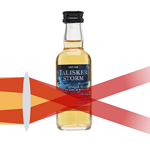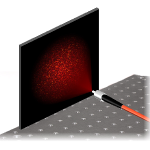Optical Sensing and Metrology
We harness light to probe the chemical structure of materials from bacteria to whiskey using Raman spectroscopy. We also develop innovative methods to measure properties of the light itself, by scrambling it into grainy speckle patterns.
Raman Spectroscopy

Laser light can excite molecules to emit Raman photons which contain important chemical fingerprints of the samples. Wavelength modulated Raman spectroscopy (WMRS) efficiently removes the auto-fluorescence from biological samples, such as cells or tissue, therefore hugely enhances the signal to noise level and its detection ability. We use this for analysis of chemicals ranging from bacteria to whiskey!
- TO FOCUS-MATCH OR NOT TO FOCUS-MATCH INVERSE SPATIALLY OFFSET RAMAN SPECTROSCOPY: A QUESTION OF LIGHT PENETRATION
G.E. Shillito, L. McMillan, G. D. Bruce, K. Dholakia, Opt. Express 30, 8876 (2022) / arXiv: 2112.08877 - PROBING VIBRATIONAL STRONG COUPLING OF MOLECULES WITH WAVELENGTH-MODULATED RAMAN SPECTROSCOPY
K. Menghrajani, M. Chen, K. Dholakia, W.L. Barnes, Advanced Optical Materials, 2102065 (2021) - THROUGH-BOTTLE WHISKY SENSING AND CLASSIFICATION USING RAMAN SPECTROSCOPY IN AN AXICON-BASED BACKSCATTERING CONFIGURATION
H. Fleming, M. Chen, G. D. Bruce and K. Dholakia, Anal. Methods / arXiv: 2005.13538 - REAL-TIME MONITORING OF LIVE MYCOBACTERIA WITH A MICROFLUIDIC ACOUSTIC-RAMAN PLATFORM
V. O. Baron, M. Chen, B. Hammarström, R. J. H. Hammond, P. Glynne-Jones, S. H. Gillespie and K. Dholakia, Commun. Bio. 3, 235 (2020) - TOWARDS AUTOMATED CANCER SCREENING: LABEL-FREE CLASSIFICATION OF FIXED CELL SAMPLES USING WAVELENGTH MODULATED RAMAN SPECTROSCOPY
L. Woolford, M. Chen, K. Dholakia and C. S. Herrington, Journal of Biophotonics 11, e201700244 (2018) - RAMAN IMAGING THROUGH A SINGLE MULTIMODE FIBRE
I. Gusachenko, M. Chen and K. Dholakia, Opt. Express 25, 13782 (2017)
Speckle Metrology

When laser light hits a rough surface, the light is scattered in many directions and the resultant interference pattern has a grainy appearance which we call speckle. This speckle is often considered as a loss of any information contained in the laser light, as much research has been devoted to avoiding it. However, the speckle is actually rich in information about both the laser and the scatterer. We have used this phenomenon to perform highly accurate measurements of laser parameters, such as attometre-resolved wavelength measurement and characterisation of
the orbital angular momentum and polarisation of the light beam. Moreover, we can use speckle to probe environmental changes, such as resolving changes of refractive index at 10-9 and picometre-level displacements of the scattering medium.
- MEASURING PICOMETRE-LEVEL DISPLACEMENTS USING SPECKLE PATTERNS PRODUCED BY AN INTEGRATING SPHERE
M. Facchin, G.D Bruce, K. Dholakia, arXiv: 2110.15939 (2021) - MEASUREMENT OF VARIATIONS IN GAS REFRACTIVE INDEX WITH 10^−9 RESOLUTION USING LASER SPECKLE
M. Facchin, G.D Bruce, K. Dholakia, ACS Photonics 9, 830-836 (2022) - SPECKLE-BASED DETERMINATION OF THE POLARISATION STATE OF SINGLE AND MULTIPLE LASER BEAMS
M. Facchin, G. D. Bruce and K. Dholakia, OSA Continuum 3, 1302-1313 (2020) - OVERCOMING THE SPECKLE CORRELATION LIMIT TO ACHIEVE A FIBER WAVEMETER WITH ATTOMETER RESOLUTION
G. D. Bruce, L . O’Donnell, M. Chen and K. Dholakia, Opt. Lett. 44, 1367 (2019) - HARNESSING SPECKLE FOR A SUB-FEMTOMETRE RESOLVED BROADBAND WAVEMETER AND LASER STABILIZATION
N. K. Metzger, R. Spesyvtsev, G. D. Bruce, B. Miller, G. T. Maker, G. Malcolm, M. Mazilu and K. Dholakia, Nat. Commun. 8, 15610 (2017) - MODAL CHARACTERIZATION USING PRINCIPAL COMPONENT ANALYSIS: APPLICATION TO BESSEL, HIGHER-ORDER GAUSSIAN BEAMS AND THEIR SUPERPOSITION
A. Mourka, M. Mazilu, E. M. Wright and K. Dholakia, Sci. Rep. 3, 1422 (2013)
